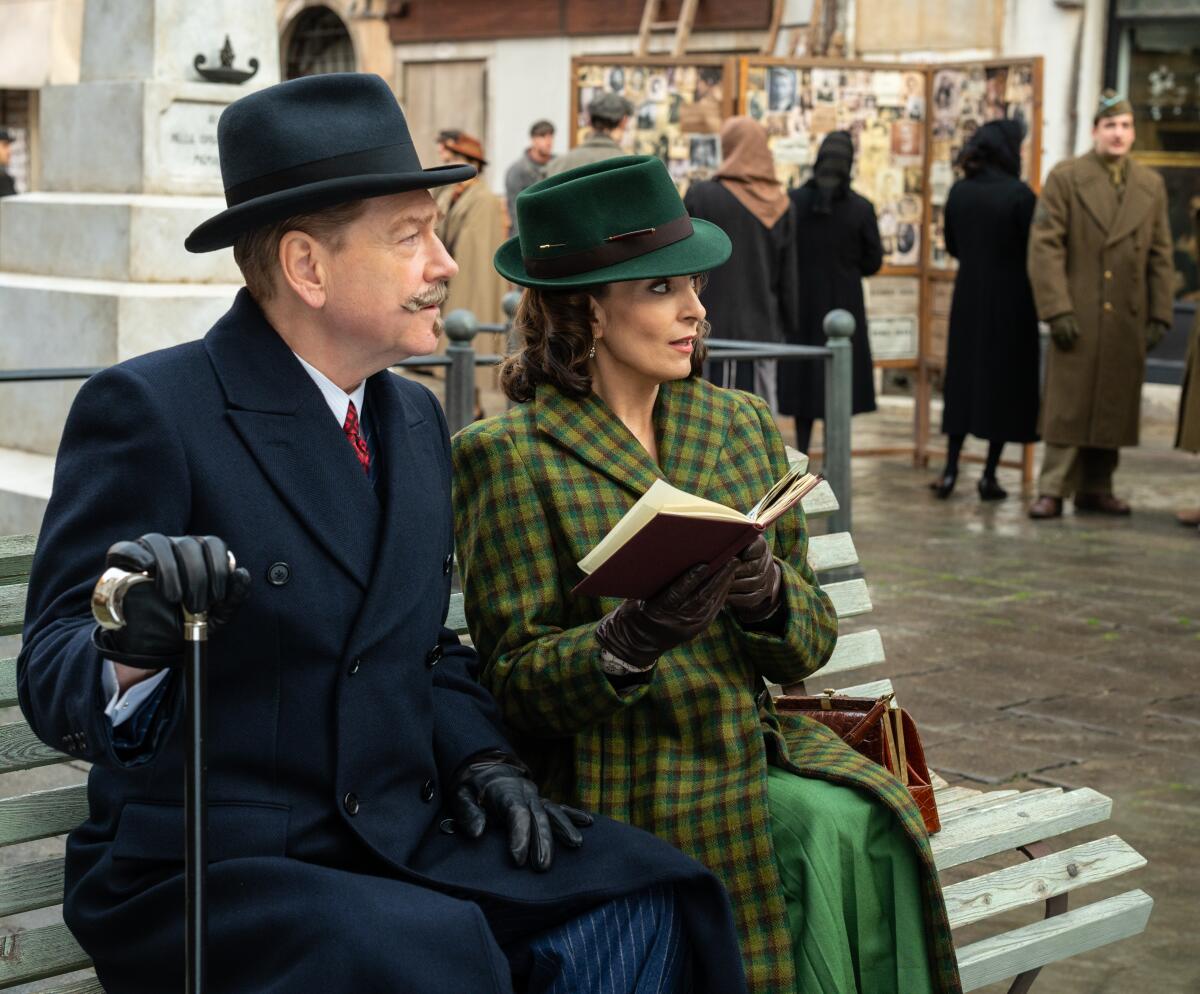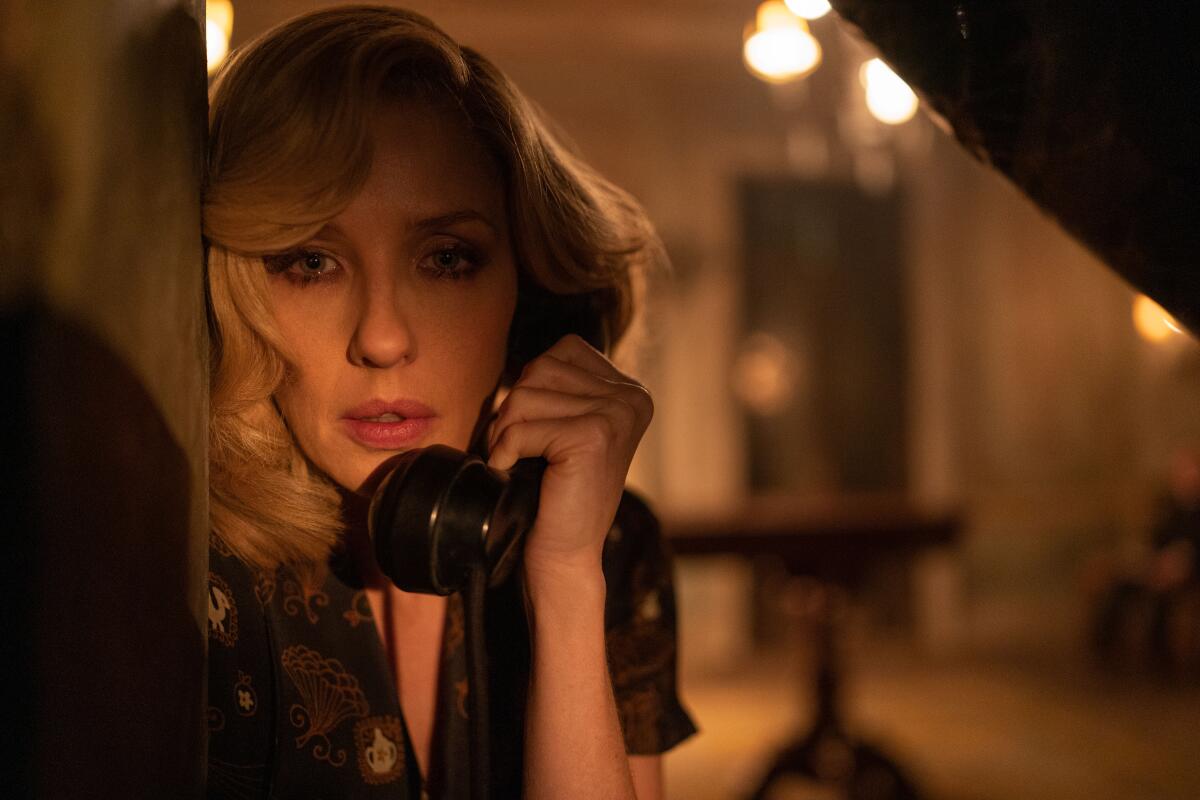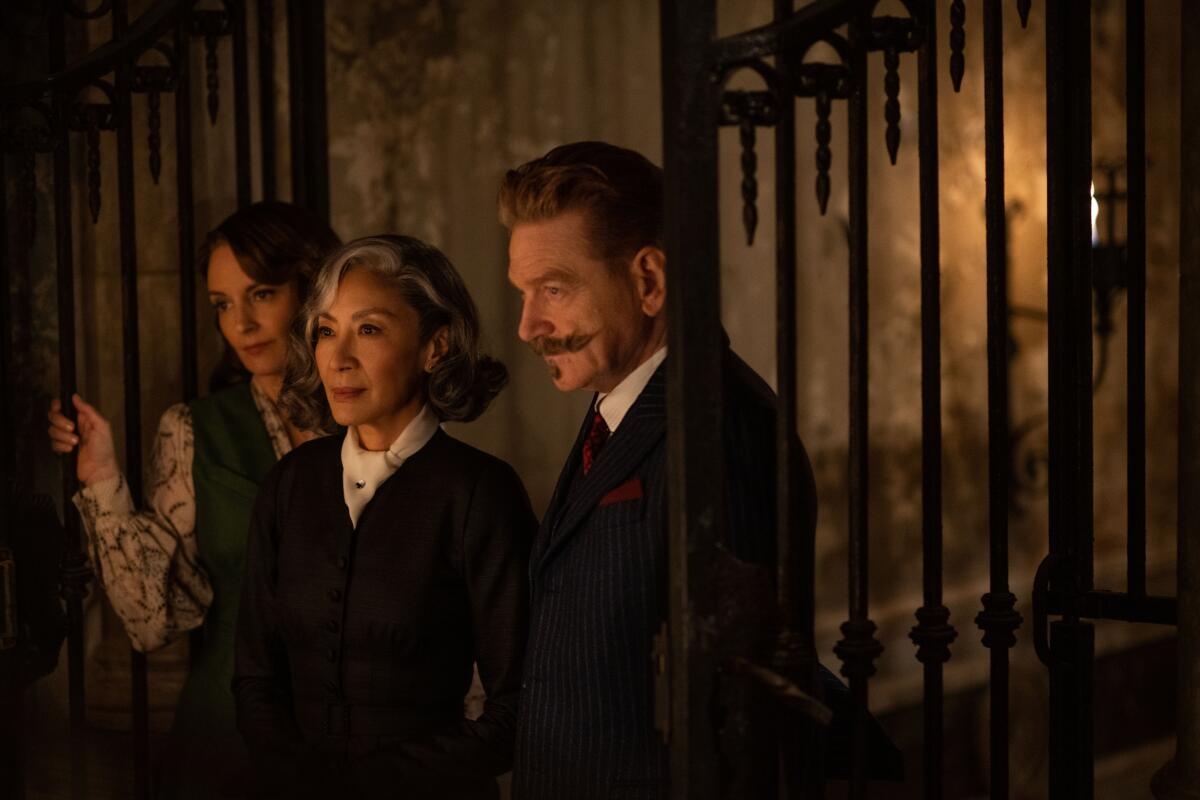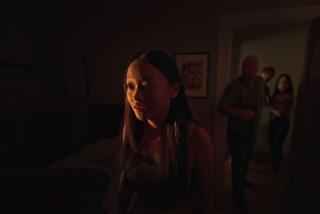With ‘A Haunting in Venice,’ Kenneth Branagh’s Agatha Christie series hits its stride

- Share via
Early on in Kenneth Branagh’s delectably creepy “A Haunting in Venice,” as gondolas cut through waterways and the sun sets on one of the world’s most impossibly beautiful cities, there arises a melody that you might recognize as “Meet Me in St. Louis, Louis.” It’s a welcome if incongruous choice of music, evoking a bright, cheery vision of early 20th-century America that is otherwise absent from the movie, which is set over a dark and stormy Halloween night in 1947 Italy. In time, though, the allusion will click into place, when a character reminisces about a time during the war when she sought refuge in the 1944 film “Meet Me in St. Louis” over and over again — a poignant testament to how movies can sustain us through our darkest hours.
But there’s more to the allusion than the usual fusty Hollywood nostalgia. “Meet Me in St. Louis,” rightly hailed as a Christmas classic, also happens to feature one hell of a Halloween sequence, where unruly, unsupervised children attack their neighbors, build bonfires in the street and at one point nearly derail a trolley car. That spirit of youthful anarchy makes it a clever reference point for “A Haunting in Venice,” which is very loosely adapted from Agatha Christie’s 1969 novel “Hallowe’en Party,” and which is particularly concerned with the mischievous doings of children, alive and dead.
The action unfolds at a crumbling Venetian palazzo that’s rumored to be haunted by the ghosts of girls and boys who perished years ago during an outbreak of the plague. That makes it a supremely atmospheric setting for a children’s All Hallows’ Eve gathering, though the main event here is the (mostly) adults-only after-party. The owner of the palazzo, a grieving opera soprano named Rowena Drake (Kelly Reilly, a master of melancholy), has invited a famous medium, Mrs. Joyce Reynolds (an entrancing Michelle Yeoh) to perform a séance. Their hope is to establish contact with the spirit of Rowena’s daughter, Alicia, who plunged to her death in the canal a year earlier, a tragedy that dovetails with the many before it and portends still more to come.

Into this house of horrors comes the famed Belgian detective and designated party-pooper Hercule Poirot (Branagh), who’s retired from official duty but still willing to take on cases that interest him — or, in this case, offend his strict rationalist instincts. Tricks and treats for the entertainment of small children are all well and good, but for Poirot, the notion of actual occult phenomena is as intolerable as an asymmetrical breakfast spread or an unkempt mustache. And the filmmakers seem to take a particular joy in irritating him this time around, seizing on the cozy tropes of the classical detective story and steering them, with jolting sound effects and grisly imagery, in the direction of full-throttle supernatural horror.
The pleasure proves infectious. Gorgeously shot on location by cinematographer Haris Zambarloukos, “A Haunting in Venice” is easily the best of Branagh’s three big-screen Christie adaptations, largely because it is also the most flagrantly unfaithful. If the earlier “Murder on the Orient Express” (2017) and “Death on the Nile” (2022) felt like lavish but superfluous retreads of beloved Christie classics, here, Branagh and screenwriter Michael Green have wisely dispensed with, and ultimately improved on, one of Poirot’s least memorable cases. In “Hallowe’en Party,” a 13-year-old girl is found drowned in an apple-bobbing tub; for the movie, it’s Poirot himself who is nearly pomme-eled to death, assailed from behind by a killer whose ruthlessness is less surprising than their identity.
With the release of ‘A Haunting in Venice,’ two Christie obsessives weigh in on the enduring appeal of an author who’s been outsold only by the Bible and Shakespeare.
The victims, suspects, motives and complications pile up swiftly but lucidly. Rowena’s guests, not all of whom were invited, include an angry chef (Kyle Allen), a watchful bodyguard (Riccardo Scamarcio), two shifty Hungarian travelers (Ali Khan and Emma Laird), a troubled doctor and his precocious son (Jamie Dornan and Jude Hill, poignantly updating their parent-child dynamic from Branagh’s “Belfast”). There’s also an intensely religious housekeeper (a tremulous Camille Cottin) who, like Yeoh’s wide-eyed mystic, mounts a fervent, faith-based explanation for the eerie goings-on at the palazzo, where children’s singsong voices issue forth from the darkness and chandeliers fall and windows burst open of their own accord.
Poirot reacts to all this legerdemain with a disbelieving scowl, even when he can’t fully explain the hair-raising tricks his eyes and ears are playing on him. He is joined in his skepticism, up to a point, by his longtime friend Ariadne Oliver (a very welcome Tina Fey), a successful mystery novelist who functioned in the books as a self-parodying avatar for Christie herself. That dynamic plays out differently here, partly because the character has been recast as an American. Enlivened by Fey’s vinegary wit and Green’s acerbic dialogue, this Miss Oliver is a snappier, more sardonic presence, keeping Poirot’s sizable ego in check even as she tries to lure him out of super-sleuth retirement. She wants to reawaken his sense of purpose and also perhaps her own, to find fresh creative inspiration in an adventure replete with violent death and gothic splendor.

Branagh certainly succeeds in finding his, as do his gifted collaborators (they include production designer John Paul Kelly and costume designer Sammy Sheldon). Filming on location in Venice, of course, has long been a reliable source of cinematic ensorcellment; if it is possible to shoot an unattractive or unevocative frame of this city, Zambarloukos hasn’t managed it. He and Branagh retain their fondness for extremely canted angles, but here those visual flourishes — a sideways-slanted shot of a piazza, an upward-gazing shot of an open doorway — serve to underscore the spookiness of the setting, the sense of madness that seeps into the air like poison. This is a world whose secret passageways and pitch-black shadows you can get all too happily lost in.
With its paranormal activity and seemingly impossible crimes (including a murder in a locked room), “A Haunting in Venice” sometimes feels closer to the work of the great John Dickson Carr than Christie, even if the solution to the mystery, though clever and convincing, falls short of those authors’ signature ingenuity. What lingers from this movie isn’t the usual assemblage of clues and red herrings — a child’s doll, a jar of honey, a hidden telephone — but a free-floating air of grief, much of it rooted in the characters’ turbulent memories of the war just a few years earlier.
Branagh’s Poirot, himself a World War I veteran, has bared his own physical and psychological scars in this series before. For the first time, though, his backstory doesn’t feel concocted for effect. Instead, it subtly resonates with a case whose rich human dimensions — deferred dreams, unshakable traumas, grieving parents and children — sound a grim echo of the world beyond the whodunit. For all the creakily derivative supernatural hokum on display, the ghosts that haunt this movie turn out to be all too persuasively real.
'A Haunting in Venice'
Rating: PG-13, for some strong violence, disturbing images and thematic elements
Running time: 1 hour, 40 minutes
Playing: Opens Sept. 15 in general release
More to Read
Only good movies
Get the Indie Focus newsletter, Mark Olsen's weekly guide to the world of cinema.
You may occasionally receive promotional content from the Los Angeles Times.










